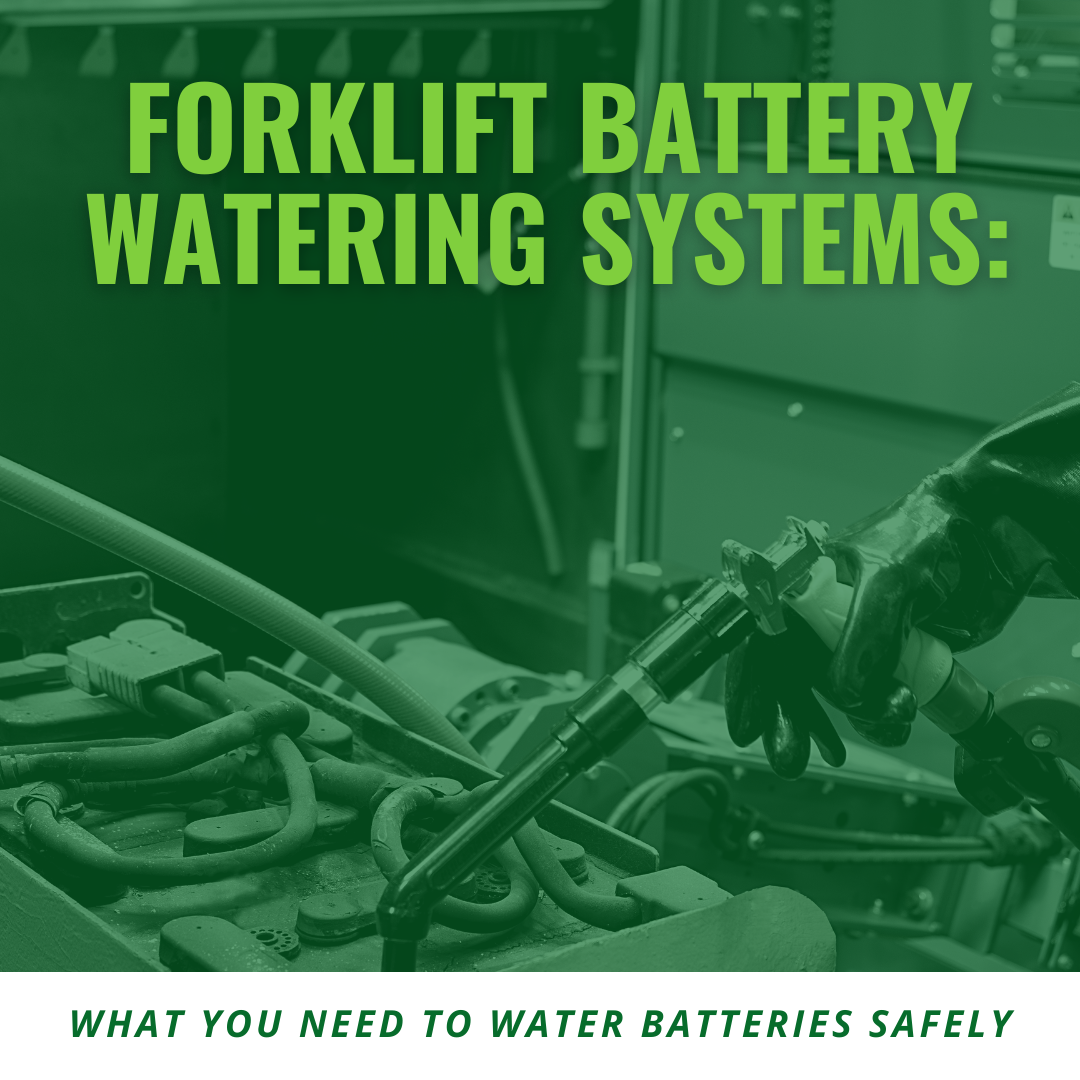We use cookies to make your experience better. To comply with the new e-Privacy directive, we need to ask for your consent to set the cookies. Learn more.
Forklift Battery Watering Systems: What You Need to Water Batteries Safely
To keep lift trucks running, businesses need to keep batteries in excellent condition. Batteries, after all, are the single most expensive forklift component — and the single element most responsible for the unit’s operation. Poor maintenance can affect the lift truck’s functionality, reducing operating times and increasing the number of change-outs.

Lift truck battery maintenance is fairly straightforward, but managers need to stick to strict schedules to keep their fleets in prime condition. This is particularly important during battery watering. As everyone who regularly works with electric lift trucks knows, lead-acid batteries need frequent watering to maintain appropriately mixed electrolyte. When lift truck batteries aren’t regularly watered, electrolyte levels become unbalanced, leading to preventable damage. Improper watering can reduce a battery’s lifespan by years, creating potential safety hazards in the process.
Most managers understand the practical importance of battery watering devices, but they should also consider how the right equipment can make the process easier, safer, and more efficient. Portable battery watering systems have numerous benefits for both employers and employees.
Here are a few things to keep in mind when choosing battery watering systems for your fleet:
Choose a battery watering method that works for your facility.
Some operations still use gravity-fed systems for watering, in which a distilled water tank is elevated above the batteries. Water from the tank flows into each cell, and a worker cuts off the feed when the cell is filled. The major disadvantage of this method is its inconvenience; to water in a different location, the entire system must be moved. Gravity feed battery watering systems may not have automatic shutoffs, which increases the risk of under- or over-watering.
Mobile tanks improve on this process by allowing operators to perform maintenance virtually anywhere in a facility. The BHS 10-Gallon Mobile Bladder Tank uses an internal air bladder to provide constant pressure, ensuring consistent, precise watering. A capacity gauge gives visual feedback during battery watering, further reducing the risk of boil-overs and dry plates. The 10-Gallon AC-Powered Watering Cart is another option for small to mid-sized operations. With a 13-foot power cord and 12-foot output hose, it’s an affordable solution for watering batteries on the floor when AC power is readily available. And for bulk battery watering with full mobility, the BHS Battery Watering & Filling System Tank carries up to 330 gallons on a lift truck or pallet jack.
Ensure a steady flow rate for lift truck battery watering devices.
While mobile tanks greatly improve efficiency, they should always be equipped with hoses or water guns to control the feed of the water. A forklift battery watering system should be capable of delivering water at a fast rate, but too much power can make tanks and carts difficult to use.
Products like the WG-X Water Gun allow for optimal efficiency with a 1.7 gal/min (6.4 L/min) fill speed and a built-in flow diffuser to maintain a consistent flow rate throughout the watering process. A non-electric automatic shutoff mechanism prevents overwatering, and a flow indicator shows when filling is complete. This ensures that workers can move quickly from battery to battery while minimizing the risk of overwatering.
Prioritize ergonomics when choosing a battery watering system.
The WG-X also features an ergonomic design to prevent musculoskeletal injuries caused by awkward bending. Lift truck battery maintenance often involves lifting, bending, and twisting — but the right equipment can reduce these hazardous movements, and proper ergonomics pays off in the long term.
Choose equipment that’s designed to promote natural, ergonomic movements. Watering guns should have curved nozzles and easily operable handles, while carts and tanks should be maneuverable without the aid of additional equipment. Employers cannot afford to overlook ergonomics when choosing equipment for crucial battery maintenance tasks.
Establish a process for watering batteries.
High-quality battery watering systems make maintenance much simpler, but proper training goes a long way towards establishing an efficient battery room. Operators should understand the importance of watering, and managers should carefully establish routine maintenance schedules. Every member of an operation’s staff must work together to keep the fleet running at its maximum potential.
These general guidelines can help to establish proper watering techniques:
- Water forklift batteries at the start of every shift.
- Allow batteries to cool before watering.
- Never water batteries before or during charging.
- Record all battery maintenance to establish accountability.
- Establish procedures for handling boil-overs and other emergencies.
With the right equipment — and proper management — forklift batteries can operate reliably for upwards of five years. Actual lifespans depend on usage and other factors, but regular watering is the most important consideration. A precise battery watering system is an excellent long-term investment for keeping your fleet on the floor. Call Solus Group at 314-696-0200 to learn more about battery maintenance solutions for the whole fleet.
